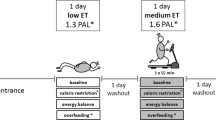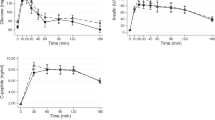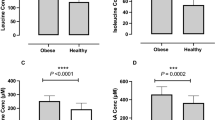Abstract
Background/Objectives:
The metabolic responses to mixed breakfast meals with different glycemic indexes (GI) and their effects on substrate metabolism during exercise in adolescent girls have not been examined. The interaction with weight status also warrants investigation. This study investigated the effect of mixed breakfast meals containing high GI (HGI) or low GI (LGI) carbohydrates on metabolic responses and fat oxidation during rest and exercise in overweight (OW) and non-overweight (NO) adolescent girls.
Subjects/Methods:
A total of 8 OW and 12 NO adolescent girls consumed an isoenergetic HGI (GI=73) or LGI (GI=44) breakfast 120 min before completing a 30-min treadmill walk at 50% V̇O2peak.
Results:
Peak blood glucose concentration was higher for HGI compared with LGI in OW (P=0.023), but not NO (P>0.05) girls. Blood glucose total area under the curve (TAUC) was 13% higher in HGI compared with LGI in OW (P=0.006), but only 4% higher in NO (P=0.072) girls. Plasma insulin data were loge transformed (lninsulin). Plasma lninsulin concentrations were not different between HGI and LGI (P>0.05). Peak plasma lninsulin concentration (P=0.016) and TAUC (P=0.001) were greater in OW than NO girls. Fat oxidation during postprandial rest and exercise was not different between breakfasts (P>0.05).
Conclusions:
The elevated glycemic response in HGI compared with LGI was more pronounced in OW girls, suggesting a reduced ability to cope with the metabolic demands of the HGI, but not LGI, breakfast. Manipulation of breakfast GI did not alter fat oxidation during rest or subsequent moderate intensity exercise in OW and NO adolescent girls.
This is a preview of subscription content, access via your institution
Access options
Subscribe to this journal
Receive 12 print issues and online access
$259.00 per year
only $21.58 per issue
Buy this article
- Purchase on Springer Link
- Instant access to full article PDF
Prices may be subject to local taxes which are calculated during checkout


Similar content being viewed by others
References
Anderson GH, Woodend D (2003). Effect of glycemic carbohydrates on short term satiety and food intake. Nutr Rev 61, S17–S26.
Atkinson FS, Foster-Powell K, Brand-Miller JC (2008). International tables of glycemic index and glycemic load values: 2008. Diabetes Care 31, 2281–2283.
Backhouse SH, Williams C, Stevenson E, Nute M (2007). Effects of the glycemic index of breakfast on metabolic responses to brisk walking in females. Eur J Clin Nutr 61, 590–596.
Ball SD, Keller KR, Moyer-Mileur LJ, Ding YW, Donaldson D, Jackson WD (2003). Prolongation of satiety after low versus moderately high glycemic index meals in obese adolescents. Pediatrics 111, 488–494.
Barton BA, Eldridge AL, Thompson D, Affenito SG, Striegel-Moore RH, Franko DL et al. (2005). The relationship of breakfast and cereal consumption to nutrient intake and body mass index: the National Heart, Lung, and Blood Institute Growth and Health Study. J Am Diet Assoc 105, 1383–1389.
Boyd AE, Giamber SR, Mager M, Lebovitz HE (1974). Lactate inhibition of lipolysis in exercising man. Metabolism 23, 531–542.
Cho S, Dietrich M, Brown CJ, Clark CA, Block G (2003). The effect of breakfast type on total daily energy intake and body mass index: results from the Third National Health and Nutrition Examination Survey (NHANES III). J Am Coll Nutr 22, 296–302.
Cole TJ, Bellizzi MC, Flegal KM, Dietz WH (2000). Establishing a standard definition for child overweight and obesity worldwide: international survey. BMJ 320, 1240–1243.
Díaz EO, Galgani JE, Aguirre CA, Atwater IJ, Burrows R (2005). Effect of glycemic index on whole-body substrate oxidation in obese women. Int J Obes (Lond) 29, 108–114.
Frayn KN (1983). Calculation of substrate oxidation rates in vivo from gaseous exchange. J Appl Physiol 55, 628–634.
Holloway GP, Bonen A, Spriet LL (2009). Regulation of skeletal muscle mitochondrial fatty acid metabolism in lean and obese individuals. Am J Clin Nutr 89, S455–S462.
Horowitz JF, Mora-Rodriguez R, Byerley LO, Coyle EF (1997). Lipolytic suppression following carbohydrate ingestion limits fat oxidation during exercise. Am J Physiol 273, E768–E775.
Høstmark AT (2007). Variations in the glycemic response to carbohydrates: do high responders have a special benefit of using low glycemic foods? Open Nutr J 1, 1–4.
Lien L (2007). Is breakfast consumption related to mental distress and academic performance in adolescents? Public Health Nutr 10, 422–428.
Ludwig DS, Majzoub JA, Al-Zahrani A, Dallal GE, Blanco I, Roberts SB (1999). High glycemic index foods, overeating, and obesity. Pediatrics 103, E26.
Matthews DR, Hosker JP, Rudenski AS, Naylor BA, Treacher DF, Turner RC (1985). Homeostasis model assessment: insulin resistance and beta-cell function from fasting plasma glucose and insulin concentrations in man. Diabetologia 28, 412–419.
McCarthy HD, Jarrett KV, Emmett PM, Rogers I (2005). Trends in waist circumferences in young British children: a comparative study. Int J Obes (Lond) 29, 157–162.
Moore LJ, Midgley AW, Thurlow S, Thomas G, Mc Naughton LR (2010). Effect of the glycaemic index of a pre-exercise meal on metabolism and cycling time trial performance. J Sci Med Sport 13, 182–188.
Moore MC, Cherrington AD, Mann SL, Davis SN (2000). Acute fructose administration decreases the glycemic response to an oral glucose tolerance test in normal adults. J Clin Endocrinol Metab 85, 4515–4519.
Oosthuyse T, Bosch AN (2010). The effect of the menstrual cycle on exercise metabolism: implications for exercise performance in eumenorrhoeic women. Sports Med 40, 207–227.
Pal S, Lim S, Egger G (2008). The effect of a low glycaemic index breakfast on blood glucose, insulin, lipid profiles, blood pressure, body weight, body composition and satiety in obese and overweight individuals: a pilot study. J Am Coll Nutr 27, 387–393.
Perälä MM, Hätönen KA, Virtamo J, Eriksson JG, Sinkko HK, Sundvall J et al. (2011). Impact of overweight and glucose tolerance on postprandial responses to high- and low-glycaemic index meals. Br J Nutr 25, 1–8.
Pi-Sunyer FX (2002). Glycemic index and disease. Am J Clin Nutr 76, S290–S298.
Riddell MC, Jamnik VK, Iscoe KE, Timmons BW, Gledhill N (2008). Fat oxidation rate and the exercise intensity that elicits maximal fat oxidation decreases with pubertal status in young male subjects. J Appl Physiol 105, 742–748.
Rowlands DS (2005). Model for the behaviour of compartmental CO2 stores during incremental exercise. Eur J Appl Physiol 93, 555–568.
Sandercock GR, Voss C, Dye L (2010). Associations between habitual school-day breakfast consumption, body mass index, physical activity and cardiorespiratory fitness in English schoolchildren. Eur J Clin Nutr 64, 1086–1092.
Schenk S, Davidson CJ, Zderic TW, Byerley LO, Coyle EF (2003). Different glycemic indexes of breakfast cereals are not due to glucose entry into blood but to glucose removal by tissue. Am J Clin Nutr 78, 742–748.
Schwartz MB, Vartanian LR, Wharton CM, Brownell KD (2008). Examining the nutritional quality of breakfast cereals marketed to children. J Am Diet Assoc 108, 702–705.
Sinha R, Fisch G, Teague B, Tamborlane WV, Banyas B, Allen K et al. (2002). Prevalence of impaired glucose tolerance among children and adolescents with marked obesity. N Engl J Med 346, 802–810.
Slaughter MH, Lohman TG, Boileau RA, Horswill CA, Stillman RJ, Van Loan MD et al. (1988). Skinfold equations for estimation of body fatness in children and youth. Hum Biol 60, 709–723.
Song WO, Chun OK, Kerver J, Cho S, Chung CE, Chung SJ (2006). Ready-to-eat breakfast cereal consumption enhances milk and calcium intake in the US population. J Am Diet Assoc 106, 1783–1789.
Sparks MJ, Selig SS, Febbraio MA (1998). Pre-exercise carbohydrate ingestion: effect of the glycemic index on endurance exercise performance. Med Sci Sports Exerc 30, 844–849.
Stevenson EJ, Astbury NM, Simpson EJ, Taylor MA Macdonald IA (2009). Fat oxidation during exercise and satiety during recovery are increased following a low-glycemic index breakfast in sedentary women. J Nutr 139, 890–897.
Stevenson EJ, Williams C, Mash LE, Phillips B, Nute ML (2006). Influence of high-carbohydrate mixed meals with different glycemic indexes on substrate utilization during subsequent exercise in women. Am J Clin Nutr 84, 354–360.
Stevenson EJ, Williams C, Nute ML (2005). The influence of the glycaemic index of breakfast and lunch on substrate utilisation during the postprandial periods and subsequent exercise. Br J Nutr 93, 885–893.
Tanner JM (1962). Growth at Adolescents. Blackwell Scientific: Oxford UK.
Timmons BW, Bar-Or O, Riddell MC (2007). Energy substrate utilization during prolonged exercise with and without carbohydrate intake in preadolescent and adolescent girls. J Appl Physiol 103, 995–1000.
Tittelbach TJ, Mattes RD, Gretebeck RJ (2000). Post-exercise substrate utilization after a high glucose vs. high fructose meal during negative energy balance in the obese. Obes Res 8, 496–505.
Wee SL, Williams C, Tsintzas K, Boobis L (2005). Ingestion of a high-glycemic index meal increases muscle glycogen storage at rest but augments its utilization during subsequent exercise. J Appl Physiol 99, 707–714.
Weiss R, Dziura J, Burgert TS, Tamborlane WV, Taksali SE, Yeckel CW et al. (2004). Obesity and the metabolic syndrome in children and adolescents. N Engl J Med 350, 2362–2374.
Willett W, Manson J, Liu S (2002). Glycemic index, glycemic load, and risk of type 2 diabetes. Am J Clin Nutr 76, S274–S280.
Wolever TM, Jenkins DJ (1986). The use of the glycemic index in predicting the blood glucose response to mixed meals. Am J Clin Nutr 43, 167–172.
Wolever TM, Vorster HH, Björck I, Brand-Miller J, Brighenti F, Mann JI et al. (2003). Determination of the glycaemic index of foods: interlaboratory study. Eur J Clin Nutr 57, 475–482.
Wu CL, Nicholas C, Williams C, Took A, Hardy L (2003). The influence of high-carbohydrate meals with different glycaemic indices on substrate utilisation during subsequent exercise. Br J Nutr 90, 1049–1056.
Zakrzewski J, Tolfrey K (2011). Exercise protocols to estimate Fatmax and maximal fat oxidation in children. Ped Ex Sci 23, 122–135.
Zunquin G, Theunynck D, Sesboüé B, Arhan P, Bouglé D (2009). Comparison of fat oxidation during exercise in lean and obese pubertal boys: clinical implications. Br J Sports Med 43, 869–870.
Acknowledgements
We thank the Tanita Grant In Aid for funding this research, all of the participants and their parents for their commitment to our study and Professor Clyde Williams for his advice. We also thank Mr Graham Bett, Mr Ian Smith and Mrs Sophie Diaper from Woodbrook Vale High School, Loughborough for their support with this study.
Author information
Authors and Affiliations
Corresponding author
Ethics declarations
Competing interests
The authors declare no conflict of interest.
Rights and permissions
About this article
Cite this article
Zakrzewski, J., Stevenson, E. & Tolfrey, K. Effect of breakfast glycemic index on metabolic responses during rest and exercise in overweight and non-overweight adolescent girls. Eur J Clin Nutr 66, 436–442 (2012). https://doi.org/10.1038/ejcn.2011.175
Received:
Revised:
Accepted:
Published:
Issue Date:
DOI: https://doi.org/10.1038/ejcn.2011.175
Keywords
This article is cited by
-
Modeling of postprandial glycemic response by consecutive reaction kinetics model for precise glycemic control
International Journal of Diabetes in Developing Countries (2023)
-
Health relevance of lowering postprandial glycaemia in the paediatric population through diet’: results from a multistakeholder workshop
European Journal of Nutrition (2023)
-
Glycemic index, glycemic load, and metabolic syndrome in Mexican adolescents: a cross-sectional study from the NHNS-2012
BMC Nutrition (2017)
-
Effects of breaking up prolonged sitting following low and high glycaemic index breakfast consumption on glucose and insulin concentrations
European Journal of Applied Physiology (2017)



